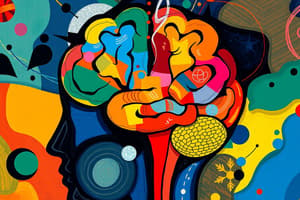Podcast
Questions and Answers
Wat beschrijft de cognitieve aanpak in de psychologie?
Wat beschrijft de cognitieve aanpak in de psychologie?
- De geest kan geen complexe informatie verwerken.
- De geest functioneert als een computer die informatie verwerkt. (correct)
- Cognitief functioneren is volledig onafhankelijk van externe invloeden.
- De geest is een passieve ontvanger van informatie.
Wat is een kenmerk van een module in de informatieverwerking?
Wat is een kenmerk van een module in de informatieverwerking?
- Modules beïnvloeden elkaar tijdens het proces.
- Modules zijn altijd afhankelijk van bewustzijn.
- Modules werken alleen met visuele informatie.
- Modules verwerken informatie zonder externe verstoring. (correct)
Welke theorie beschrijft hoe objecten worden herkend door middel van het vergelijken van beelden?
Welke theorie beschrijft hoe objecten worden herkend door middel van het vergelijken van beelden?
- Feature Integratie Theorie
- Feature Detectie Theorie
- Template Matching (correct)
- Marr's Computationele Theorie
Wat houdt de Feature Integratie Theorie in?
Wat houdt de Feature Integratie Theorie in?
Wat is de functie van aandacht volgens de capaciteit modellen?
Wat is de functie van aandacht volgens de capaciteit modellen?
Wat is een belangrijk kenmerk van Marr's Computationele Theorie?
Wat is een belangrijk kenmerk van Marr's Computationele Theorie?
Wat stelt de Filter Model van aandacht voor?
Wat stelt de Filter Model van aandacht voor?
Wat is het doel van de Feature Detectie Theorie?
Wat is het doel van de Feature Detectie Theorie?
Wat is een kenmerk van het werkgeheugen?
Wat is een kenmerk van het werkgeheugen?
Wat onderscheidt impliciete van expliciete herinneringen?
Wat onderscheidt impliciete van expliciete herinneringen?
Wat beschrijft de modal model van geheugen?
Wat beschrijft de modal model van geheugen?
Wat is de functie van het visuospatial sketchpad in Baddeley's werkgeheugenmodel?
Wat is de functie van het visuospatial sketchpad in Baddeley's werkgeheugenmodel?
Hoe beïnvloedt de rotatie van mentale beelden de tijdsduur van verwerking?
Hoe beïnvloedt de rotatie van mentale beelden de tijdsduur van verwerking?
Wat omvat de definitie van sensorisch geheugen?
Wat omvat de definitie van sensorisch geheugen?
Wat zijn heuristieken in probleemoplossing?
Wat zijn heuristieken in probleemoplossing?
Wat is een belangrijk aspect van iconisch geheugen?
Wat is een belangrijk aspect van iconisch geheugen?
Flashcards
Cognitieve benadering
Cognitieve benadering
De geest werkt als een computer die informatie verwerkt.
Module
Module
Een afzonderlijke informatieverwerkingseenheid die informatie ontvangt, omzet en naar andere modules zendt zonder invloed.
Patronenherkenning
Patronenherkenning
Herkennen van objecten in de omgeving, zoals template matching, feature detectie, en recognition-by-components.
Marr's Computationele Theorie
Marr's Computationele Theorie
Signup and view all the flashcards
Template Matching
Template Matching
Signup and view all the flashcards
Feature Detection Theorie
Feature Detection Theorie
Signup and view all the flashcards
Aandacht
Aandacht
Signup and view all the flashcards
Filtermodel (Aandacht)
Filtermodel (Aandacht)
Signup and view all the flashcards
Geheugen
Geheugen
Signup and view all the flashcards
Zintuiglijk geheugen
Zintuiglijk geheugen
Signup and view all the flashcards
Werkgeheugen
Werkgeheugen
Signup and view all the flashcards
Langetermijngeheugen
Langetermijngeheugen
Signup and view all the flashcards
Modal Model
Modal Model
Signup and view all the flashcards
Baddeley's werkgeheugenmodel
Baddeley's werkgeheugenmodel
Signup and view all the flashcards
Kosslyn's theorie
Kosslyn's theorie
Signup and view all the flashcards
Probleemoplossing
Probleemoplossing
Signup and view all the flashcards
Study Notes
Cognitive Approach to the Mind
- The mind is viewed as a computer that processes information
- Modules are distinct information-processing units that work independently
- They receive, transform, and transmit information to other modules
Pattern Recognition
- Pattern recognition is the ability to identify objects in the environment
- Key theories include template matching, feature detection, recognition by components, feature integration, and Marr's computational approach
Template Matching
- A stimulus image is matched to an internal representation
- Recognition occurs if the two match
- Different templates needed for various stimulus variations
Feature Detection Theory
- Features like oriented line segments are extracted from the stimulus
- The number and type of features help determine object identity
Feature Integration Theory
- Features are extracted pre-attentively
- Combined in a focused attention stage
- Pre-attentive processing is enough for targets differing in one aspect
- Focused attention needed for targets distinct in multiple aspects
Attention
- Attention is a concentrated mental activity that can be allocated amongst alternatives
- Attention can be selective (focus on one source) or distributed (divided between sources)
- It can be shifted among sources
Theories of Attention
- Historically, several attention theories have existed
- Filter model: Information from one source is allowed into consciousness; other channels are blocked
- Attenuation model: Some filtered information may pass through
- Deutsch-Norman model: Information filtering can happen later based on semantic content
- Multi-mode model: Allows early sensory selection and later semantic selection
Capacity Models of Attention
- Attention is viewed as a resource with variable capacity
- Allocation of attention depends on available capacity and needed activities
- Kahneman's theory uses a box-and-arrow diagram visualizing this allocation
- Biased competition theory (Desimone and Duncan) relates to neuroscience
Studying That Suits You
Use AI to generate personalized quizzes and flashcards to suit your learning preferences.
Description
Dit quiz behandelt de cognitieve benadering van de geest, met nadruk op hoe de geest functioneert als een computer die informatie verwerkt. Er wordt ook aandacht besteed aan patroonherkenning, template matching en de verschillende theorieën omtrent functie-detectie en integratie van kenmerken.




